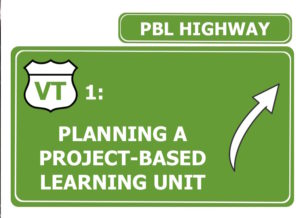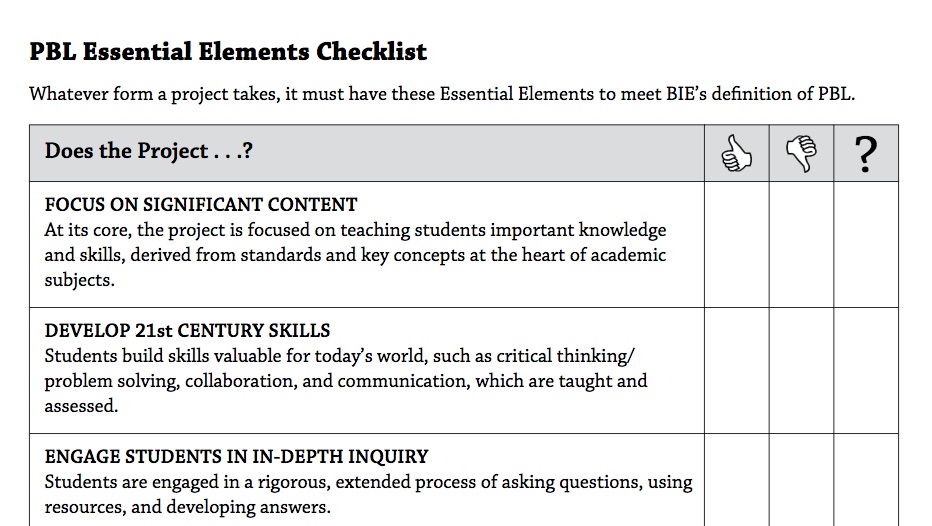Resources to tackle project-based learning
 Welcome to the PBL Highway, my new series aimed at helping you on the road to project-based learning! Setting up a student-driven, rigorous, community-focused project-based learning (PBL) unit can feel daunting, so the best way to tackle anything this huge (it’s yuge!) is to break it down into manageable steps.
Welcome to the PBL Highway, my new series aimed at helping you on the road to project-based learning! Setting up a student-driven, rigorous, community-focused project-based learning (PBL) unit can feel daunting, so the best way to tackle anything this huge (it’s yuge!) is to break it down into manageable steps.
A little forward planning — some templates, checklists and rubrics — and you got this.
The 4 stages of project-based learning (PBL)
Different organizations name the stages differently, but the essence of each is the same:
- start with an exciting entry event;
- create a driving question (either with students or teacher-driven);
- enter the research and creation phase;
- and finish with an authentic community sharing opportunity.
With all that in mind, where to start?
Start with The Driving Question.
- Every PBL unit is centered around a driving question, which is a relevant problem or question for students to solve. Good questions, according to this post:
- Tie into learning standards;
- Address a real-world problem that relates to the students’ experiences and community;
- Inspire students to find a solution that will have a long-lasting impact on their community.
-
Examples of Driving Questions:
- What impact has the Vermont Marble Company historically had on the town of Proctor, Vermont? How can that impact be felt today?
- How can we protect Vermont forests from invasive species?
- What challenges does each climate zone face?
- How do idling cars impact the air quality at our school?
Next, make it authentic.
- Connect the driving question to a local event or problem that impacts their students and their community. For example, students from Proctor Elementary School, in Proctor VT, will be visiting Vermont television station WCAX to learn what goes into a weather report before they create their own weather reports with a green screen.
- Students at Shelburne Community School collected data around carbon emissions and idling cars in front of their school. The project’s authenticity came from both the data and the larger idea that they were getting involved in measuring the quality of the air they themselves breathed all day.

- Bring community members into the classroom to share their experiences. When possible, bring in community members online or in person to share relevant information. This can be interviewing a scientist about invasive species, or a local community member sharing the history of the town. For instance, to kick off their water quality unit, students at Hazen Union School, in Hardwick, VT, arranged for a visit from water science students from the University of Vermont. The UVM students taught a hands-on workshop about watersheds, and that gave Hazen information they needed to begin water quality testing in the brook behind their school.
- Have students create a product that solves a real-world problem and helps their local community. At Proctor Junior High, students will create museum displays for the Vermont Marble Museum that showcase the history of marble quarrying in the area. These displays will help inform visiting community members.
Now you’re ready to plan the details of your unit.
Here’s where digital tools can really help you get and stay organized.
PBL Planning Template:
I created this PBL planning template from my own resources as well as those from the Buck Institute and Edutopia. Make a copy of the Google Doc (File > Make a copy…) and add it to your Drive or share it with your students’ Drives.
PBL Essential Elements Checklist:
This list is also useful in organizing all the pieces you’ll need for your PBL unit:
Now is a great time to think ahead to your culminating event
The culminating event of a PBL unit is an event where students present the results of their research to an engaged and authentic audience. It can be an open-house for the community, or a formal presentation to the docents of the Vermont Marble Museum — or even a guest lecture at UVM to those watershed scientists! Think about who’d really benefit from the information your students will be collecting, and then ask your students what feels comfortable to them in terms of the event.
Creating a calendar is incredibly helpful with a PBL unit. Start with the culminating event, and work backwards, week by week. A simple calendar template can be found here.
PHEW! My goodness, take a breather.
You’re doing a lot of planning here, and you’re doing it really well. You’re thinking about how to meet your students’ needs and set them up for success, and you’re involving them in setting up the Driving Question and deciding on a Culminating Event. You should probably pause here and reward yourself with some chocolate or a cat video.

Feel better? Great!
Here are a few more ideas to help you in planning a PBL unit:
Create the supports and scaffolds that you need.
PBL needs different levels of support and scaffolding depending on the grade level, the project and the individual group. Start thinking about:
- Clear roles: Many groups and students need clear roles in PBL. These can be tailored to the specfic needs of a group. You can find our simplified recommended roles here (ready to use with students), and more roles ideas here.
- Check-in tools: Students in PBL need frequent check ins with a teacher. These can be scheduled or done as needed, but be sure to plan plenty of time to check in with students. Check-ins can be done in-person, or in an online forum, or via email. Just plan on making time to support valuable questions!
- Reflection tools: Much of the learning in PBL takes place during reflection. These can be exit tickets, journal entries, blog posts, and more. Here are some great prompts to get your students thinking about reflection: tickets out/reflections
Create/find assessment tools.
- Review rubrics for teamwork, transferable skills, products. What can you adapt, use or recreate?
- Rubrics use “I can…” “I do…” “I understand…” language
- Rubric language is positively framed: Begins… Approaching…Meets…Exceeds
- Transferable skills. Keep in mind much of PBL helps meet the transferrable skills in Vermont. These can be the focus of your assessment, formative or summative, and can also help guide your reflection opportunities.
- You might decide on a few assessments for your PBL plan: one for reflection; one for ongoing teamwork; and one for the final product and presentation.
Don’t worry if this feels like a lot, I’m going to go really in-depth on these scaffolds in a later post in the series.
In the meantime, hit me up in the comments: where are you with planning your PBL unit, and what kinds of questions do you have?




This is great help! Thank you!